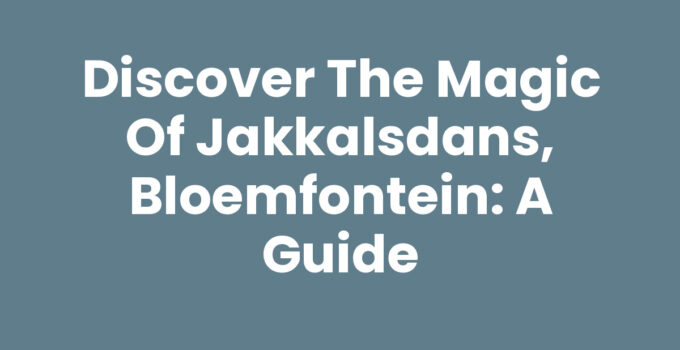Welcome to the enchanting world of Jakkalsdans, a significant cultural dance originating from the heart of Bloemfontein. This traditional dance not only celebrates the rich heritage of the region but also brings communities together in joy and festivity. In this article, we will delve into everything you need to know about Jakkalsdans—from its history and cultural significance to how you can participate in this unique expression of artistry.
Jakkalsdans, Bloemfontein: A Cultural Journey
Jakkalsdans, also known as the Jackal dance, has roots deeply embedded in the folklore of South Africa. This traditional form of dance reflects the rhythm of nature and the lifestyle of the local communities. It often mimics the movements of the jackal, hence its name, and is characterized by energetic footwork and vivid storytelling.
Historical Background
The origins of Jakkalsdans trace back to the indigenous people of the Free State Province, where legends and stories about jackals were passed down through generations. As early as the 19th century, this dance form was documented as a key aspect of local celebrations and gatherings, symbolizing survival, community strength, and connection to the earth.
Learning the Basics of Jakkalsdans
If you’re interested in learning Jakkalsdans, here’s a simple guide to get you started:
- Find the Right Space: Ideally, practice in an open area where you can move freely. Traditional settings are often outdoors, enhancing the connection to nature.
- Study the Movements: Jakkalsdans consists of lively movements that often involve foot stomping, hip swaying, and arm gestures that emulate a jackal’s behavior. Watch local performances online or attend workshops to learn these movements.
- Practice Rhythm: The music plays a vital part in Jakkalsdans. Listen to traditional South African music to familiarize yourself with the beats that accompany the dance.
- Engage with a Community: Join local cultural associations or dance groups in Bloemfontein. Being part of such a community not only teaches you the dance but also immerses you in the culture.
Regular practice will help you master the intricacies of Jakkalsdans and allow you to fully appreciate its cultural significance.
See Also: Explore the Life and Impact of Dan Pienaar, Bloemfontein
The Importance of Jakkalsdans in Community Events
Jakkalsdans is more than just a dance; it is a medium through which communities celebrate significant milestones such as weddings, harvests, and festivals. During these events, the dance fosters unity and brings joy. Participants often dress in vibrant attire that reflects local customs, creating a picturesque display of culture.
Benefits of Participating in Jakkalsdans
Participating in Jakkalsdans offers numerous benefits beyond the physical activity:
- Cultural Awareness: Engaging in traditional dances like Jakkalsdans enables individuals to learn about and embrace cultural heritage.
- Community Engagement: Dancing brings people together, fostering social connections and strengthening bonds within the community.
- Physical Health: The energetic movements of Jakkalsdans promote physical fitness, enhancing strength, flexibility, and cardiovascular health.
Recommended Guide: Top Tennis Clubs Bloemfontein: Your Ultimate Guide
Conclusion
In conclusion, Jakkalsdans, a vibrant dance from Bloemfontein, encapsulates the spirit of community and cultural heritage. Whether you are a spectator or aspiring dancer, this traditional form of expression offers a unique glimpse into the local lifestyle and values. Get involved, learn the steps, and participate in this lively celebration of life!
Recommended Guide: The Ultimate Guide to Volunteering in Bloemfontein
Frequently Asked Questions
What is Jakkalsdans?
Jakkalsdans is a traditional South African dance from Bloemfontein, characterized by lively movements that mimic a jackal.
How can I learn Jakkalsdans?
You can learn Jakkalsdans by studying performances, attending workshops, and practicing with local cultural groups in Bloemfontein.
What events feature Jakkalsdans?
Jakkalsdans is often featured in community celebrations, including weddings, harvest festivals, and cultural events.



